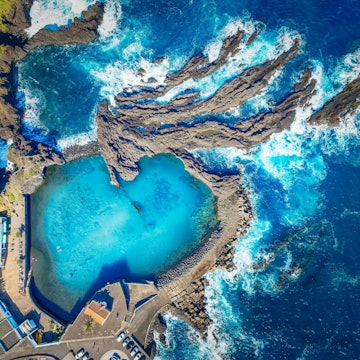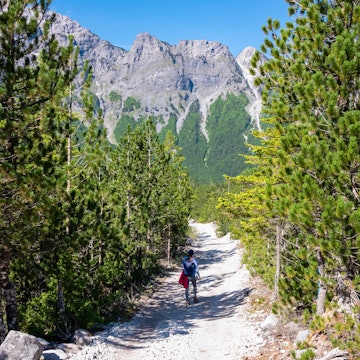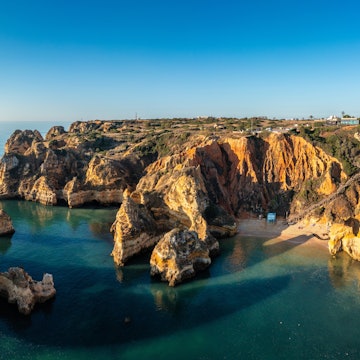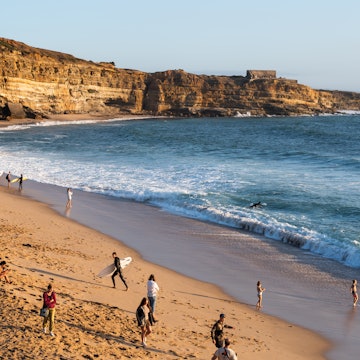

The Church of Saint George, Wasserburg on Lake of Constance, the third largest lake in Europe. © Shutterstock
Europe in the springtime puts on a sensational show for the smallest of crowds.
Head here to hike in quiet wonder to dreamy Mediterranean beaches that are all but empty, spot wildlife emerging from its deep winter slumber, and witness the seasonal eruption of wildflowers on mountain slopes, in verdant valleys, and along the coastline. There’s a gentle buzz in the towns and cities now, as the weather warms and cafe terraces and hotels fill, but the big-hitter sights are nowhere near as packed as they are in summer.
Whether you fancy visiting Northern Mallorca’s honeyed hill towns, Norway’s waterfall-splashed Southern Fjords, or Pembrokeshire’s puffin islands, we’ve got you covered in our round-up of the 10 best spring break destinations in Europe – some familiar, some perhaps less so.

1. Western Algarve, Portugal
If the Algarve makes you think of all-inclusive resorts and cheap-as-chips package holidays, you’re missing a trick. Go west and you’ll see a thrillingly wild, less-touristy side to this chunk of southern Portugal. No high-rises just pretty whitewashed villages. Here cliffs nose-dive to the booming Atlantic and great arcs of butterscotch sand ripple through with dunes. And during spring break, when the coast is freckled with wildflowers, you might get the beach all to your lucky self. The surfing here is sensational. Come in March to catch the monster waves at the tail-end of the winter season, or April and May for gentler surf.
The turning point is the lighthouse-topped headland of Cabo de São Vicente, the last fleck of land many Portuguese navigators saw before sailing into the unknown on their mighty caravels. Swinging north of here brings you to a necklace of gorgeous beaches: rugged Praia do Amado, surf-smashed Carrapateira, and crescent-shaped Praia da Arrifana close to the Moorish, castle-crowned town of Aljezur. You’re now in the heart of the Parque Natural do Sudoeste Alentejano e Costa Vicentina, a nature reserve of cliffs, wetlands, and salt marshes, home to wildlife including otters, wildcats, Iberian lynx, and ospreys.

2. São Miguel, The Azores
Middle of nowhere, you say? How about The Azores for spring break? Dropped like stepping stones across the mid-Atlantic, this cluster of lusciously subtropical volcanic islands are like a forgotten world, with their ragged, waterfall-draped cliffs, deep-blue crater lakes, and lichen-fuzzed cloud forests straight out of Jurassic Park. Despite feeling incredibly remote, the islands are technically still part of Portugal (and therefore Europe).
You’ll most likely touch down on São Miguel, the biggest island and a terrific springboard for exploring, with a pinch of everything that makes this archipelago so memorable. Top billing goes to the geothermal wonders of Furnas, with its hissing geysers, turquoise crater lake, hot spring pools, and the botanical gardens of Terra Nostra, frothing with pink azaleas in spring. In the west, the vast caldera and twin lakes of Sete Cidades entrance. Myth has it they were formed by the tears of star-crossed lovers – a green-eyed princess and a blue-eyed shepherd.
São Miguel’s capital, Ponta Delgada, is a gracious town of whitewashed, basalt-trimmed, balconied mansions. It’s also the starting point for marine biologist-led whale-watching tours with Futurismo. You can spot dolphins and sperm whales year-round, but things step up a gear in April and May when migratory species like blue, fin, and sei whales rock up.
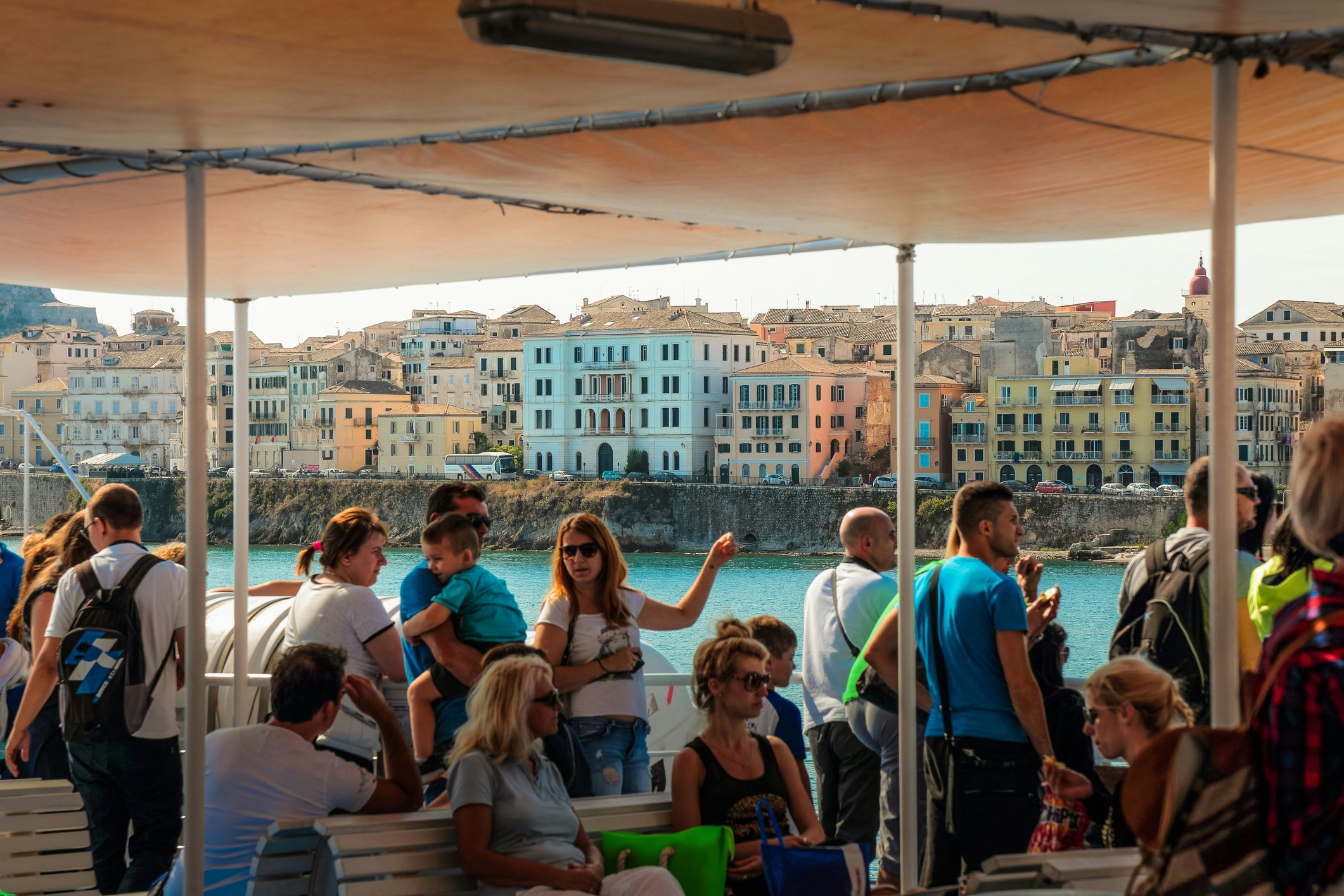
3. Corfu, Greece
If overtourism has cast something of a shadow over the largest of the Ionian Islands, it’s during spring break that Corfu's nature really shines. Now is the arcadian season of crisp light, where wildflowers enwreathe olive groves, fireflies flash, owls hoot in night skies, and snow still polishes the summits of Albania, which sits 2km (1.25 miles) across the sapphire-blue Ionian Sea. Orthodox Easter brings the beauty of candlelit parades.
It’s warm but not hot in spring: perfect for exploring. Hike a leg of the wild 220km-long (137 miles) Corfu Trail (take a GPS or map), from Kavos in the south to Agios Spiridon in the north, and often you’ll be alone with the shushing waves and clanging goat bells. Or else hop from one exquisite turquoise bay to the next on the west coast: cliff-wrapped, monastery-topped Paleokastritsa and pristine, nudist Myrtiotissa.
Culture? Venetian Corfu Town (Kerkyra) is a heart-stealer, with its twin fortresses built to repel the Ottomans, an alley-woven old town, and a Parisian-style Liston arcade for people-watching and frappé sipping. A sightseeing drive? Head up twisting roads to time-lost, stone-built Old Perithia, then across a lonely karst plateau to the summit of 906m (2972ft) Mt Pantokrator.

4. Lake Constance, Germany
Making a splash between three countries (Germany, Switzerland, and Austria), Lake Constance is Central Europe’s third largest lake. And what a beauty it is. In summer, its shores get swamped, so come during spring break instead for more peace, a riot of cherry and apple blossoms in the orchards, rhododendrons and tulips blooming in lakeside gardens, and a light dusting of snow still on the nearby Alps. This is also prime time for getting on your bike to pedal all – or some – of the 273km-long (170 miles) cycle path, which loops around the lake past vineyards, a castle, a harbor, and a half-timbered town. If you run out of steam, ferries join the dots – and you can take bikes on board.
On German shores, Roman-rooted Konstanz delivers a serious whack of culture with its sky-high, 1000-year-old Münster. Other unmissables include Mainau’s luscious Mediterranean gardens and baroque palace, the Unesco-listed Pfaulbauten prehistoric pile dwellings, and postcard-pretty, castle-topped, vine-swathed Meersburg, where you can sip local wines and bubble in the thermal waters of its lakefront, mountain-facing spa.

5. Madeira
It’s nicknamed the 'island of eternal spring' for its subtropical vegetation and year-round warm weather, but Madeira really is a botanist’s fantasy when in full springtime flower, with its riot of lilies, orchids, passion flowers, broom, jacaranda, wisteria, red hot poker trees, and star jasmine. The best blooms adorn floats and costumes at Funchal’s phenomenally colorful Flower Festival parades in April and May.
Closer to Africa than Portugal, this spectacularly rugged, cliff-rimmed, mountain-buckled island is never more enticing than during spring break, when you can enjoy precious peace hiking the levadas – the 15th-century irrigation channels that wriggle across the heights and through ferny laurisilva (laurel) forests ripe for Middle Earth. For a shot of city life, hit the Atlantic-gazing capital Funchal for wine tasting, a dash through Monte’s steep streets in a wicker toboggan with a Carreiro (sled driver), and perfumed strolls in the Jardins Botânicos da Madeira. A view, you say? Make for the glass-floored skywalk at Cabo Girão, atop one of the world’s highest sea cliffs.

6. Northern Mallorca, Spain
Before you sniff at the idea of Mallorca, know that the little-miss-popular of the Med is an entirely different island in spring before the masses descend. Now rosemary blooms purple on cliffs that dive to sapphire seas, the last pink-white almond blossom sprinkles the meadows like confetti, and goat bells are the backbeat on hiking trails threading high into the jagged, cave-pitted limestone peaks of the Unesco-listed Serra de Tramuntana in the island’s north.
Ah, the north! This is where Mallorca takes a serious turn for the wilder and spring break is the time to see it – on foot, by bike, or on a road trip. With a week or, better still, two you can plot a fantastic trip. Begin with the cliff-hugging coastal road to cape Formentor and its pine-flecked beach, then take the twisty road west to honey-hued Pollença, where life plays out on cafe terraces. From there, the Ma-10 climbs into the mountains and Renaissance-baroque Monestir de Lluc with its Gaudí touches, and one ridiculously pretty hill town after the next: Fornalutx, eyrie-like Deià (where poet Robert Graves once lived) and orchard-embedded Sóller, with its vintage train, modernist architecture and galleries showcasing Picasso and Miró.

7. Pembrokeshire, Wales
Wales isn’t all drizzle. When the sun shines in spring, it’s as though the world has been made anew, with daffodils nodding in hedgerows, bluebells hazing broadleaf woods, and lambs skipping gleefully around meadows. In the country’s southwestern crook, Pembrokeshire is quiet and ravishing now, with smuggler coves mercilessly beaten by the Atlantic and rocks whittled into form since dinosaurs walked the earth. Nature really pulls out the stops around the time of spring break, with flowers (primroses, violets, bluebells, pink thrift, sea campion, and oxtail daisies) and a storm of migratory birds returning to these wind-ruffled shores.
The best way to explore? Hook onto a leg of the 186-mile (299km) Pembrokeshire Coast Path, which heads up and over stiles, gorse-clad cliff, dune-flanked beaches, hidden coves, and headland from Amroth in the south to St Dogmaels and its history-filled Benedictine abbey in the north. The trail ticks off astonishing beaches like Barafundle Bay and Broad Haven South, wild headlands like Strumble Head and Dinas Island, St Davids and its magnificent medieval cathedral, and many a prehistoric standing stone, Iron Age hillfort, and site of Celtic saintly legend.
For close-up wildlife encounters, boat out to the islands. The puffins are returning in their thousands to cliff-rimmed Skomer (in May, you can see the first pufflings pop out of burrows), and nesting guillemots, razorbills, fulmars, kittiwakes, and shags flock to RSPB reserve Ramsey Island.

8. Lake Geneva
Other parts of Switzerland are still kicking the snow off their skis at this time of year, but Lake Geneva is blessed with a warmer climate. Hugging the southern shore, Geneva is a knockout in spring – the big crowds have yet to arrive, the parks and botanical gardens spread along the Quai du Mont Blanc brim with azaleas and rhododendrons, and pearly Mt Blanc in the not-so-distance French Alps dazzles in the crisp light. Easter aside, it’s pretty quiet, brilliant for seeing sights like the sky-high, rainbow-kissed Jet d’Eau fountain, or running, walking or cycling (rent a bike with Genèveroule) around the lake.
The joy of Lake Geneva is that you can easily breeze all over the place by boat or train. Daytrip it to Lausanne, with its hilly medieval center, Olympic heritage, and newfound cultural buzz at Plateforme 10, a cool arts district in revamped train sheds. Or take a picnic up into the steeply terraced vineyards of the Unesco World Heritage Lavaux. Montreux enthralled Lord Byron and the Shelleys in the 19th century and it still has an old-world glamour about it today. For full-on spring break magic, stroll along the mansion-dotted shore to fairy-tale fort Château de Chillon in the fire of sunset.

9. Southwestern Fjords, Norway
Trip-wise, Norway tends to either get shoved into winter (northern lights and Arctic snow) or summer (midnight sun), but during spring break, well, who knew? Now you do and, trust us, the Southwestern Fjords really hit the mark. Because while it’s still pretty nippy up north, the south is warming up nicely, with longer, lighter days, wildflowers in bloom, and lots of melting snow turning the waterfalls into a proper crash-bang spectacle. Kayak, hike, cycle, swim (if you’re brave), or sit out on a waterfront terrace in pretty-as-a-picture seaport cities like Bergen and Stavanger for the first utepils (beer in the sun) of the year.
Stavanger is a great jump-off point for boating across the Lysefjord, where scenery like cliffs punch high above true-blue waters. You’ll find some of Norway’s most heart-stoppingly beautiful hikes right here: Preikestolen (Pulpit Rock) and Kjeragbolten. And some seriously sexy digs, too: The Bolder, for instance.
Between here and Bergen there’s a fretwork of fjords to explore: among them mighty Hardangerfjord, with thousands of fruit trees blossoming during spring break, incredible waterfalls, and gorgeous, back-to-nature, above-it-all escapes like Woodnest.

10. East Coast Sardinia, Italy
Summer gets all the love, but primavera on the Italian island of Sardinia is better. As the island shakes off winter, the great outdoors bursts back to life – jacaranda trees bloom purple, broom gilds the hillsides and the island is smothered in wildflowers and fragrant macchia. With only a trickle of the summer crowds, you can snag a good deal on a sea-view hotel room or get a tranquil hit of the good life at an agriturismo (farm stay) tucked among olive, orchard, and vine if you plan your activities around spring break.
It’s too hot in summer to do much more than flop on a beach, but spring ramps up the outdoor adventure big time, especially on the wild east coast with hiking, rock climbing, kayaking, and road biking on the hairpin-riddled SS125. Where the ragged limestone mountains of the Supramonte crash down to celestial blue sea views, the Golfo di Orosei is strung with coves only reachable by boat or on foot: from ravine-backed Cala Luna to dreamy, white-pebble Cala Biriola and out-of-this-world Cala Goloritzè.
Go now and you’ll get the trails and landscape largely to yourself – whether it’s to be an uphill trudge through a lush, silent valley to the mysterious Bronze Age ruins of Tiscali, or the half-day return trek to Gola Su Gorropu, where 500m-high (1640ft) walls of sheer limestone punch above a boulder-strewn ravine billed ‘Europe’s Grand Canyon’. In these quieter times, you might spot mouflon and golden eagles as spring in Europe always surprises.






